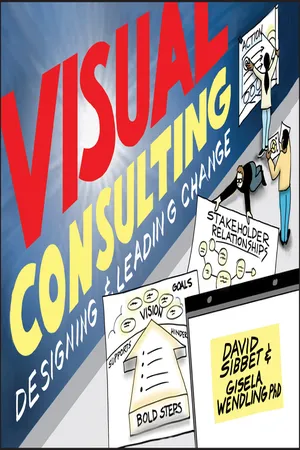
- English
- ePUB (mobile friendly)
- Available on iOS & Android
About this book
Visualization—in your own imagination, on the wall, and with media—supports any consultant who is learning to design and facilitate transformational change, leadership development, stakeholder involvement processes, and making sense of complex challenges. This book, from leaders in the field, shows you how. Building on Peter Block's Flawless Consulting, it explains how to visually contract and scope work, gather data, provide feedback, plan interventions, implement, and support on-going sustainability in organizational and community settings.
Unlike Block's work, Visual Consulting addresses the challenging problems of guiding organizational and social change processes that involve multiple levels and types of stakeholders, with interests in both local and global environments. It demonstrates how visualization and design thinking can be used to get more creative and productive results that are "owned" by everyone. The practices described apply to organizational as well as diverse, cross-boundary consulting projects. In this book, you will...
- Learn powerful visual tools for all key stages of the consulting process, including marketing your services
- Understand the predictable challenges of change and how to successfully guide organizations and communities through them
- Learn how to collaborate with clients to get sustainable results
- Find tools for using visualization comprehensively, for both inner and outer work
- Successfully guide change in both organizations and communities
The fourth installment in the Visual Facilitation series, this book teaches you how to activate the full range of visual tools, methods, and models to support stepping into successful, contemporary consulting relationships.
Frequently asked questions
- Essential is ideal for learners and professionals who enjoy exploring a wide range of subjects. Access the Essential Library with 800,000+ trusted titles and best-sellers across business, personal growth, and the humanities. Includes unlimited reading time and Standard Read Aloud voice.
- Complete: Perfect for advanced learners and researchers needing full, unrestricted access. Unlock 1.4M+ books across hundreds of subjects, including academic and specialized titles. The Complete Plan also includes advanced features like Premium Read Aloud and Research Assistant.
Please note we cannot support devices running on iOS 13 and Android 7 or earlier. Learn more about using the app.
Information
Part I.
Imagining Visual Consulting
Jumping into the Flow

1. The Potential of Visual Consulting
Integrating Methods to Get Results

California Drought Calls for Change
My Way in to Water Management
I knew asking the right questions is the key to good dialogue. I asked, “Given what we are looking at, what key question should the Roundtable take on for this year?”. . . My question surfaced a deeper question that led to a new focus “What would it take to create connections, re-connections, or effective alignments to address these systemic issues?”
Inviting a Conversation on Issues
Table of contents
- Cover
- Title page
- Copyright page
- Introduction
- Acknowledgements
- Part I: Imagining Visual Consulting Jumping into the Flow
- Part II: Visualizing Change Helping Clients Look Ahead
- Part III: Visual Consulting Practices Responding to the Challenges of Change
- Part IV: Expanding Your Resources Continuing the Journey
- Appendix
- Links
- Bibliography
- Index
- EULA